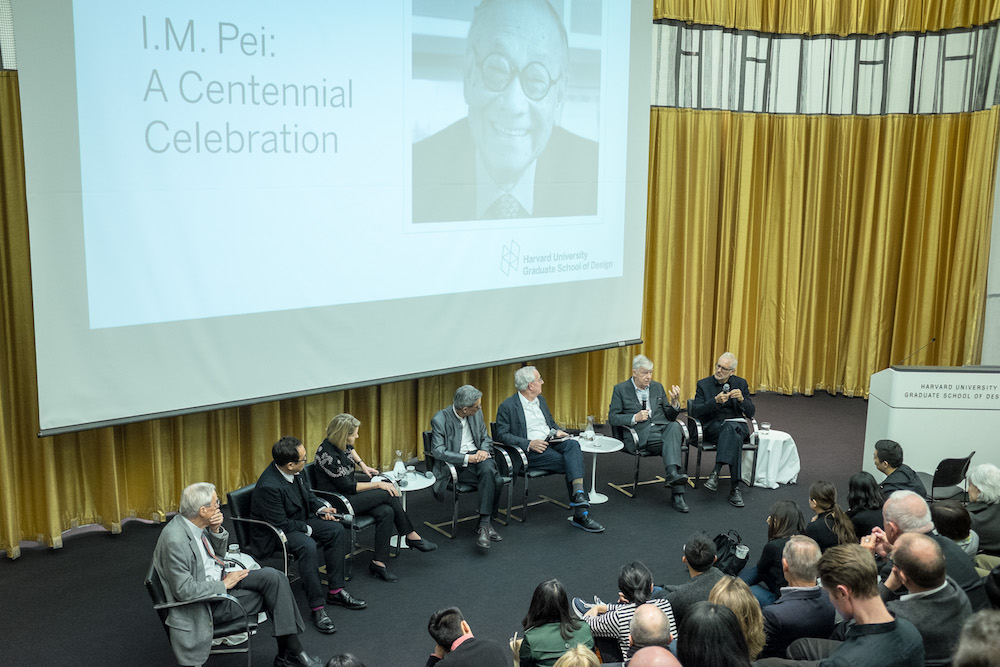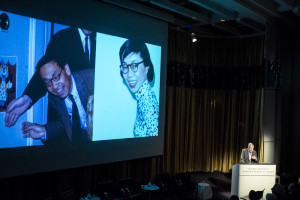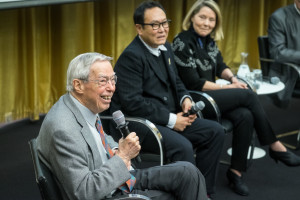The GSD Celebrates the Centennial Birthday of I. M. Pei MArch ’46 with Special Events and Exhibition
On April 26, legendary architect Ieoh Ming (I. M.) Pei MArch ’46 celebrated his centennial birthday. The 1983 Pritzker laureate lays claim to a renowned body of work that includes some of the world’s most celebrated buildings, such as the Louvre pyramid and the Bank of China Tower. With a professional career spanning six decades, Pei possesses a passion for architecture matched only by the enduring influence of his iconic designs.
On March 30, the Harvard University Graduate School of Design (GSD) honored Pei’s milestone birthday with a celebration in Gund Hall (available for view on the GSD’s YouTube channel), gathering a cast of Pei’s collaborators and friends that included Henry Cobb AB ’47, MArch ’49, Bartholomew Voorsanger MArch ’64, and Calvin Tsao MArch ’79. Architectural Record nodded to the event in a recent feature celebrating Pei’s birthday.
Threading the range of conversations and reflections was a sense of Pei’s connection to the GSD. Pei studied at the GSD, as did his late wife Eileen Pei GSD ’44 and their sons Chien Chung (Didi) Pei AB ’68, MArch ’72 and Li Chung (Sandi) Pei AB ’72, MArch ’76. I. M. Pei was also an assistant professor of architecture at the School.
Mohsen Mostafavi, dean of the GSD and Alexander and Victoria Wiley Professor of Design, began the event by calling for a “true reassessment of the work of I. M. Pei.” He outlined some of the themes of Pei’s design aesthetic that were echoed throughout the event, including the relationship between modernity, monumentality, and tradition. (The GSD, together with M+ Museum in Hong Kong, is planning a pair of symposia on Pei’s work for October 12-13 and December 15-16, 2017, with further details available in the coming weeks.)
Henry Cobb AB ’47, MArch ’49 Looks Back
Following Mostafavi’s opening remarks, Cobb, who founded his architectural practice with Pei in 1955, gave a presentation on Pei’s time at the GSD. He offered personal anecdotes about interacting with his future business partner while he was a graduate student and Pei a young faculty member.
Cobb also spoke about the “mood of the School” in the late 1940s, calling it an “exciting place” marked by epic costume parties, or “fête charrettes”—a term derived from the École des Beaux Arts in Paris. (Read more about “fête charrettes” at Harvard in the Harvard Crimson’s archives.) While acknowledging tensions between the leadership and faculty at the time over the School’s evolving pedagogy, Cobb noted that many students regarded Pei as “the best critic in the School during those years.”
Cobb also highlighted Pei’s GSD master’s thesis (1946), A Museum of Chinese Art for Shanghai, calling it “a very mature piece of work for a student.” Cobb’s presentation drew parallels between Pei’s thesis and his later professional projects, including a few of the fourteen museums Pei later designed, noting “clearly the same sensibility is at work, the same intuitive sense of balance, of lively composition in place.” Towards the end of his presentation, Cobb returned to Pei’s thesis: “I doubt if there has ever been a piece of student work that that was more predictive of a professional life to come than this project,” he noted.
Panel of Collaborators Reflect on Pei’s Career and Practice
Following Cobb’s presentation was a panel discussion moderated by Voorsanger, who worked in Pei’s practice for ten years, and Preston Scott Cohen MArch ’85, the Gerald M. McCue Professor in Architecture at the GSD.
Other panelists included structural engineer Leslie Robertson, who worked with Pei on many projects including the Miho Museum Bridge; Tsao, who began his professional career at Pei’s firm, I. M. Pei and Partners; Karen Van Lengen, the first female Design Associate at I. M. Pei and Partners; and Didi Pei, son and collaborator of I. M. Pei. A number of other partners from Pei’s practice were in attendance, including Yvonne Szeto MArch ’79. (Read Szeto’s Alumni Q&A in which she discusses some of her work with I. M. Pei).
During the discussion, panelists offered personal stories about and lessons from working with Pei. His gift for subtly guiding people—whether a client, consultant, or fellow architect—toward an idea was mentioned in different contexts throughout the conversation, and termed “ventriloquistic” by his son.
“We all left that office with some of [Pei’s] DNA,” said Voorsanger.
The idea of the Pei office as a kind of school was also illustrated by the group. Voorsanger attributed it to Pei’s ability to design “in front of you,” which allowed those around him to learn from his process. For Szeto, who joined the firm in 1977 and currently serves as a partner, the “schooling” that happens in the office comes from an atmosphere that encourages questions. Tsao added to Szeto’s observation, noting, “over and above the craft is the discipline of inquiry…I learned how to inquire and investigate through my experience [at the Pei office].”
The evening ended with a special performance by a group of GSD students who sang “Happy Birthday” to I. M. Pei in both English and Chinese.
I.M. Pei at the GSD: An Exhibition
In conjunction with the centennial-celebration event, the GSD curated an exhibition on Pei’s years at the GSD. Now on view in the GSD’s Frances Loeb Library through May 12, the show includes undergraduate and graduate work by Pei and his wife Eileen, as well as designs by students whom Pei taught while on the GSD faculty in the 1940s.
Among the exhibition materials is Pei’s master’s thesis (1946), the same one to which Cobb alluded in his presentation. Set in Pei’s native China, the museum design offered therein both embraces and challenges the Modernist pedagogy then espoused by Walter Gropius and other GSD faculty. Its combination of traditional Chinese motifs, including the bare wall and garden patio, with a distinctly modernist structure produces a sense of timelessness that Pei would return to throughout his career.
Gropius praised Pei’s thesis design in the magazine Progressive Architecture (February 1948) writing, “it clearly illustrates that an able designer can very well hold on to basic traditional features—which he has found are still alive—without sacrificing a progressive conception of design.” A model of Pei’s thesis design, created by current GSD student Marianna Gonzalez (MArch ’19), is on display in the Library show.
A series of photographs from a 1940s-era Harvard “fête charrette” that I. M. and Eileen Pei attended is also on display. It shows GSD students talking and dancing in Robinson Hall, the GSD’s home before Gund Hall opened in 1972.
The Celebration Continues
The birthday celebration and Library exhibition are part of a series of events the GSD is hosting in 2017 to honor I. M. Pei. Later this year, two symposia on the work of Pei will be held in collaboration with the museum M+: one at the GSD and the other in Hong Kong. Further details will be available in the coming weeks.
“I. M. Pei at the GSD” is on view in the Frances Loeb Library through May 12, 2017.






